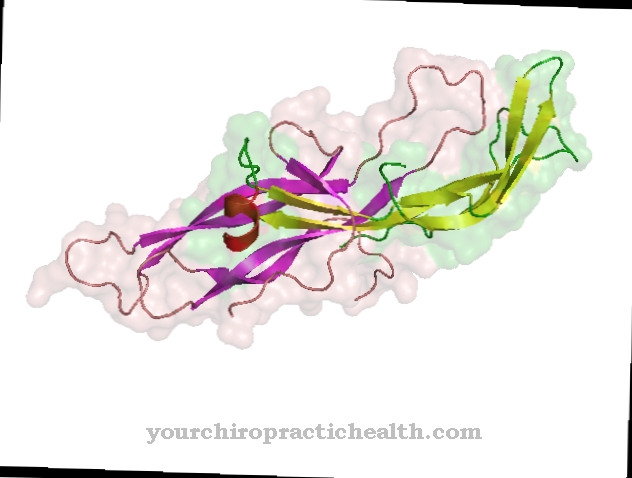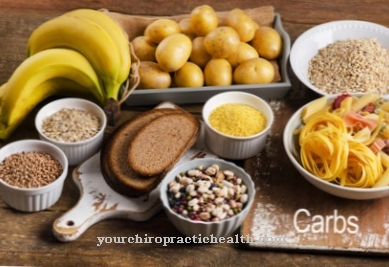Lysine is one of the essential amino acids. It participates in numerous important body functions.
What is lysine?
Lysine (Lys or K) is a proteinogenic essential amino acid. Since the human body is unable to produce lysine itself, it has to take in the basic amino acid through food. Lysine is an important building block for various proteins.
These include transport proteins within the blood plasma, enzymes, hormones and antibodies. The same applies to the structural proteins of skin, tendons and bones as well as to the proteins myosin and actin, which are characteristic of muscles.
Lysine is classified as proteinogenic because it is one of the 21 L-amino acids that are regularly incorporated into proteins. It is therefore indispensable for the biosynthesis of proteins and for the maintenance of connective tissue and muscles. Due to its chemical structure, lysine is counted among the basic amino acids. These include arginine and histidine.Due to the composition of the three amino acids from a basic group and six carbon atoms, they are also known as hexonic bases.
Function, effect & tasks
Since lysine is involved in numerous proteins, it fulfills many important functions within the human organism. For example, it is essential for the stability of connective tissue collagens.
In these structural proteins, lysine is hydroxylated and has OH residues at special points, which in turn are linked to one another via sugar molecules. In this way, the stable glycoproteins, which are one of the typical properties of collagen, can be formed.
The absorption of calcium into human bones and teeth is also influenced by lysine. Therefore, a diet rich in lysine is considered to be positive for people who suffer from bone loss (osteoporosis). Lysine is also involved in other body processes such as the formation of hormones, enzymes and antibodies, in the repair of tissue and in growth. In addition, lysine ensures that the nitrogen balance is maintained within the body.
The amino acid is also important for the immune system. So she has u. a. about antiviral properties. Scientists also suspect that lysine contributes to cardiovascular health. As a collagen component, it is extremely important for the walls of the blood vessels and strengthens the arterial walls. Lysine also ensures that lipoprotein a, which, if the concentration is too high, can lead to the blood vessel walls sticking together, does not adhere to the walls of the arteries. Existing lipoprotein plaques are removed from the amino acid, which in turn counteracts cardiovascular problems. Thus, lysine is also classified as an effective agent against arteriosclerosis.
Medical research has used lysine successfully to treat herpes. This means that the lip vesicles heal faster.
Education, occurrence, properties & optimal values
Lysine is absorbed into the human organism through the mouth. The amino acid then reaches the intestinal wall with the help of various transporters. From there it is distributed throughout the body. If there is an excess of lysine, it is excreted through the kidneys.
Lysine is primarily found in animal foods. This also includes fish, eggs, milk and dairy products. However, the amino acid is only rarely found in vegetables. Legumes such as lentils, peas and beans are an exception. In contrast, there is little lysine in grain and nuts. However, there are exceptions here too, such as rice and buckwheat. In contrast to other amino acids, lysine is more sensitive to processing processes such as roasting or toasting.
The foods rich in lysine include parmesan cheese (3170 milligrams), tuna (2210 mg), pork (2120 mg), beef and shrimp (2020 mg each), wheat germ and soybeans (1900 mg each), lentils ( 1890 mg) as well as chicken (1790 mg) and peanuts (1100 mg). The daily requirement of lysine for adults is 14 milligrams per kilogram of body weight.
There is a need in children that is three times as high. Between the ages of 10 and 12, 44 milligrams of lysine per kilogram are required. A balanced diet is sufficient to meet the need for lysine. Lysine deficiency usually only occurs in regions where mainly low-lysine grains are consumed.
Diseases & Disorders
Both a deficiency and a significant excess of lysine can have an impact on human health. In the event of a lysine deficiency, there is a risk of disorders of the body functions, for which lysine is important. These are primarily the functions of the immune system, the nitrogen balance and body growth. An unbalanced diet can lead to a lysine deficiency.
Negative effects from an excess of lysine are not to be feared in adults who consume up to 4 grams of lysine per day. However, if the doses reach high levels of 15 to 40 milligrams per day, there is a risk of diarrhea and intestinal cramps. If a person suffers from a food intolerance to eggs, milk or wheat, these foods should be avoided.
Lysine is also used by medicine as a therapeutic agent. The amino acid is used to treat and prevent herpes. The patient takes between 1 and 3 grams of lysine per day. Furthermore, lysine is considered useful for the prevention of osteoporosis. The forms of administration range from capsules in dietary supplements to infusions. Possible side effects of constant overdose are blood sugar fluctuations, blood clotting disorders and kidney dysfunction.













.jpg)

.jpg)
.jpg)











.jpg)